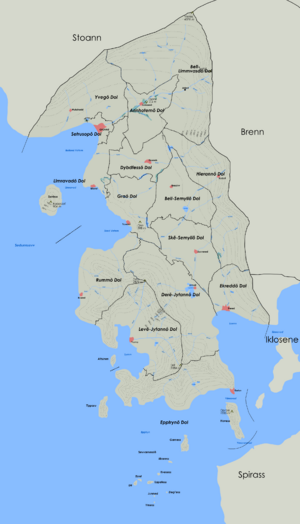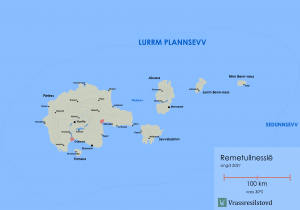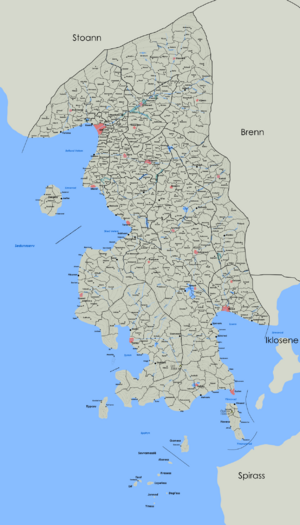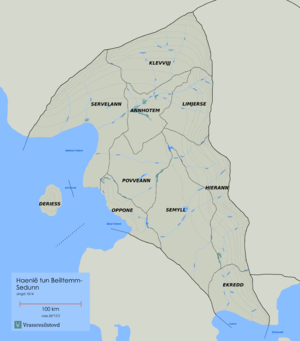Administrative divisions of Sedunn (Pacifica)
Since the administrative reform of 2014 Sedunn has three levels of administrative divisions. The territory is divided into sixteen regions (Sedunnic: dolē), which are further divided into 416 municipalities (tavvasa'lē) and 33811 districts (ovutlē). The regions are self-governing local authorities responsible for providing advanced public health care, public transportation and regional development. The municipalities have local self-governing authority and are the main welfare providers. They also provide emergency services, public social services, sanitation and urban and rural planning. The purpose of the districts is population registration, including civil registration of births, marriages, civil partnerships and deaths, and for the collation of census information.
There are eleven historical counties (Sedunnic: haenlē) that still are important in culture. The counties are still recognised officially, but since the latest administrative reform all real duties were assumed by the new regions which were designed to have a more equal population distribution. Culturally, Sedunn is also divided into Beilltemm-Sedunn (Bailtem-Sedunn) for the lands located in Bailtem and the overseas territory Remetull Islands in the South Pacific Ocean . Sometimes Beiltemm-Sedunn is subdivided into Ankjytann (Cisjytann)and Akjytann (Transjytann), dividing the mainland along the watershed line in the Jytann Mountain Range.
Regions
The region is the top-level administrative level of Sedunnic territory. The regions were created in 2014 in attempt to achieve a division with more equal population numbers than the old counties had. For example, the smallest county Deriess had a population of 175,000 while the most populous, Servelann, had almost nine million inhabitants. The region with the lowest population is now Remetull Islands with almost 1.7 million inhabitants, while the most populous one is Setrusop (the capital region) with a population of almost 6.5 million. The borders of the regions are based on the old counties to large degree. There are sixteen regions.
The regions are self-governing local authorities responsible for providing advanced public health care, public transportation and regional development. The seat of the region government is either in the largest city or the most central city.


| Coat of arms | Name | Capital | Area (km2) | Population (2019) |
|---|---|---|---|---|
| Annhotem | Lomared | 5,653 | 2,179,541 | |
| Bell-Limmvasd | Arlied | 18,851 | 2,577,126 | |
| Bell-Semyll | Eressivv | 7,208 | 2,456,612 | |
| Derē-Jytann | Urmoll | 12,388 | 3,756,167 | |
| Dybdfess | Goends | 4,869 | 3,834,373 | |
| Ekredd | Flered | 5,575 | 3,939,071 | |
| Epptryn | Durivv | 11,033 | 3,223,664 | |
| Grā | Tavenst | 6,007 | 2,125,736 | |
| Hierann | Kodull | 11,025 | 2,668,623 | |
| Levē-Jytann | Troma | 11,414 | 2,694,531 | |
| Limravad | Ullenst | 4,843 | 2,116,940 | |
| Remetullnesslē | Tarvem | 9,991 | 1,665,248 | |
| Rumm | Ilosred | 11,033 | 2,740,030 | |
| Setrusop | Grovne | 1,031 | 6,523,984 | |
| Skē-Semyll | Savvered | 7,367 | 2,117,198 | |
| Yveg | Mukshodd | 11,073 | 2,002,540 | |
| 136,628 | 46,621,383 |
Municipalities

Sedunn is divided into 319 self-governing municipalities, of which 22 are located on the Remetull Islands. The municipalities generally consist of one city or town and adjacent villages and land. The largest settlement in the municipality is generally the seat of the municipal government and the municipality is also named after it. The municipalities are the main welfare providers and also provide emergency services, public social services, sanitation and urban and rural planning.
Districts
The lowest administrative level of Sedunn is the district. The purpose of the districts is population registration, including civil registration of births, marriages, civil partnerships and deaths, and for the collation of census information.
Counties

The highest administrative level of Sedunn was the county until the 2014 reform. The counties still exist, but have no official function. There are eleven counties, and they have remained relatively unchanged from their creation in the late 15th century. The responsibilities of the counties were transferred to the regions and authority coordination regions, but they still hold a cultural significance and represent separate dialect continua.